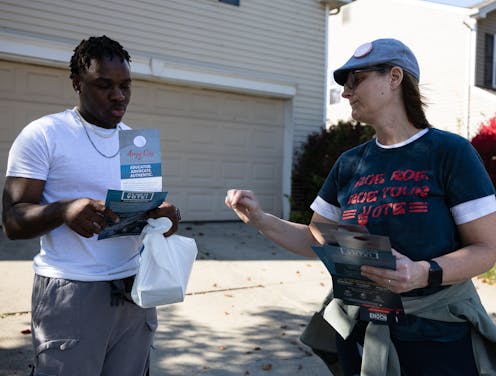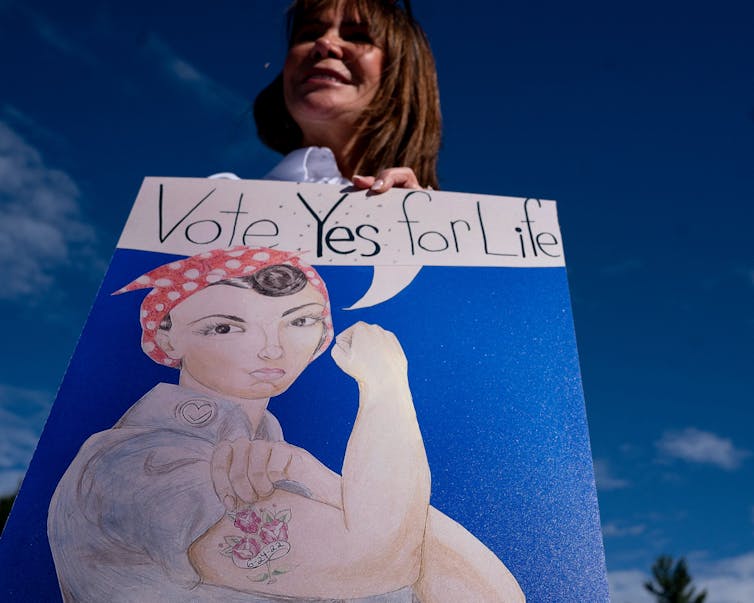Abortion is not influencing most voters as the midterms approach – economic issues are predominating
New surveys carried out by a team of social scientists find no evidence that Democrats, Republicans and independents are more likely to vote because of the Supreme Court’s abortion decision in June.

Since the Supreme Court’s June 2022 Dobbs v. Jackson decision overturning the constitutional right to abortion, election observers have raised questions about whether and how the issue of abortion will influence the outcome of the November midterm elections.
Some early survey evidence from May to July suggested a surge in support among Democrats and reproductive-aged women for abortion rights. So too did the results from an August 2022 Kansas referendum on abortion, where voters rejected a constitutional amendment that would have banned abortion. Democrats also overperformed compared with 2020 – that is, earning a higher proportion of the vote than they did in the 2020 election – in a series of congressional special elections following Dobbs.
More recent evidence, however, suggests that voter concern over inflation may trump abortion as a motivating issue.
We are a multi-university team of social scientists that has been regularly polling Americans in all 50 states since April 2020. Four times over the past six months we surveyed 22,000 to 27,000 Americans – in March and April, June and July, August and September, and then in more detail in October 2022 – to explore the likely effects of abortion politics on voter attitudes and behavior.
Following the Dobbs decision, we found no clear evidence of a change in Americans’ preferences for which party should control the House and Senate after the election. We conducted this research using generic ballots – polls that ask people about their political party preference, but not specifically about which candidate they support.
The Dobbs effect – or lack thereof
Some evidence suggests that women initially responded more strongly than men to the Dobbs decision. Young women, in particular, grew more likely to register to vote.
Yet, when we separately assess men and women, we see little evidence of a post-Dobbs spike in preferences for Democrats in the generic ballot among either men or women. While men hover near a 50-50 split in preferences between Republicans and Democrats, majorities of women across each survey wave prefer Democrats to Republicans. The consistency over time suggests that the Dobbs decision did not notably increase preferences for Democrats.
But what about turnout? Would the Dobbs decision prompt more people to cast a ballot?
Among Republicans and independents, self-reported likelihood of voting appears relatively unaffected by the Dobbs decision.
We did see a small – 1.6 percentage points – spike among Democrats reporting that they were “very likely” to vote immediately after the Dobbs ruling. The increase was twice as large – 3.2 points – among Democratic women. However, both numbers returned to their pre-Dobbs levels in our August-September survey.
In our October survey, the likelihood of voting rose across all groups, presumably due to a combination of the rising intensity of election campaigns and the inclusion of respondents who report already having voted.
When we break likelihood of voting out by gender, we do see a jump among women, across parties, reporting that they were very likely to vote immediately after the Dobbs decision – rising from 54.8% to 58% of Democratic women from early June, just prior to Dobbs, to late June, just after the Dobbs decision.
Just below 58% of Republican women, meanwhile, said that they were very likely to vote prior to Dobbs, rising to 60% immediately following the Dobbs announcement. And 29.9% of independent women said that they would vote prior to Dobbs, up to 32.5% following the announcement of the ruling.
However, once again, the bounce appears fleeting.
By August, all three partisan subgroups had reverted to pre-Dobbs levels of vote intention. Among men, in turn, we see no bounce at all.

Dobbs or no Dobbs
We also included an experiment in the October survey wave to explore whether prompting people to think about the Dobbs decision would affect their vote preferences or likelihood of voting. We showed a random subset of survey participants a paragraph about the Dobbs decision, while the rest of the survey respondents did not receive a paragraph about Dobbs. We then asked how likely they were to vote in the 2022 midterm elections and how much abortion mattered for their candidate choice in the election.
We find that survey respondents who read about Dobbs - that is, who we primed to think about it - were no more or less likely to say they intended to vote than those who did not read about Dobbs.
They were also no more or less likely to say that abortion was important for their choice of candidates. This pattern emerges regardless of party, gender or personal importance of the abortion issue.
Perhaps most important, the results from our experiment are consistent with the trends over time that we reported above, further suggesting that the Dobbs decision may not increase turnout or substantially alter vote preferences.
The Supreme Court’s Dobbs v. Jackson decision may have initially mobilized some voters in June and July, particularly women, but its effects appear to have diminished when we asked Americans about their intentions to vote again in August and October.
Small margins could change the game
Notwithstanding our survey results, it remains possible that abortion may affect the 2022 midterm results.
Elections, especially in swing states, are often decided by very small margins, potentially too small to be detected in surveys. A difference of half a percent in vote shares caused by abortion attitudes, for instance, could sway the result of a consequential election.
When we asked Americans to name the most important problems facing the nation in our October survey, overall, abortion was not among the top five issues mentioned, with inflation, the economy, crime and violence, health care and climate change ranking as more important.
However, abortion remained notably important among Democrats – mentioned by nearly 24% of those we polled – and women – mentioned by nearly 19%.
So, while we cannot offer firm predictions regarding the effect of the Dobbs decision on the 2022 elections, and we found no clear evidence of such an effect, the possibility remains that abortion could motivate enough voters to influence outcomes in at least some key races.
Matthew A Baum has received funding from the National Science Foundation.
Alauna Safarpour, Jonathan Schulman, and Kristin Lunz Trujillo do not work for, consult, own shares in or receive funding from any company or organization that would benefit from this article, and have disclosed no relevant affiliations beyond their academic appointment.
Read These Next
As DOJ begins to release Epstein files, his many victims deserve more attention than the powerful me
Powerful men connected to Jeffrey Epstein are named, dissected and speculated about. The survivors,…
The world risks forgetting one of humanity’s greatest triumphs as polio nears global eradication − 7
Polio may finally be defeated in the next 5 years. Will the world recognize what an extraordinary achievement…
Autocracies in transition: In 2025, Cameroon and Tanzania rulers clung to power — but look more vuln
The countries, whose respective leaders recently won widely disputed elections, offer contrasting examples…






